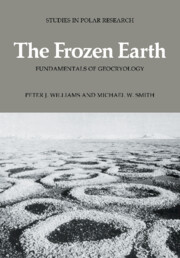Book contents
- Frontmatter
- Contents
- Symbols
- Preface
- Acknowledgements
- 1 PERIGLACIAL CONDITIONS
- 2 MORPHOLOGY OF PERMAFROST AND SEASONALLY FROZEN GROUND
- 3 CLIMATE AND FROZEN GROUND
- 4 THE GROUND THERMAL REGIME
- 5 THE FORMS OF THE GROUND SURFACE 1: SLOPES AND SUBSIDENCES
- 6 THE FORMS OF THE GROUND SURFACE 2: STRUCTURES AND MICROTOPOGRAPHY OF LEVEL GROUND
- 7 THERMODYNAMIC BEHAVIOUR OF FROZEN SOILS
- 8 HYDROLOGY OF FROZEN GROUND
- 9 THE MECHANICS OF FROZEN GROUND
- 10 GEOCRYOLOGY PAST AND FUTURE
- References
- Index
2 - MORPHOLOGY OF PERMAFROST AND SEASONALLY FROZEN GROUND
Published online by Cambridge University Press: 24 October 2009
- Frontmatter
- Contents
- Symbols
- Preface
- Acknowledgements
- 1 PERIGLACIAL CONDITIONS
- 2 MORPHOLOGY OF PERMAFROST AND SEASONALLY FROZEN GROUND
- 3 CLIMATE AND FROZEN GROUND
- 4 THE GROUND THERMAL REGIME
- 5 THE FORMS OF THE GROUND SURFACE 1: SLOPES AND SUBSIDENCES
- 6 THE FORMS OF THE GROUND SURFACE 2: STRUCTURES AND MICROTOPOGRAPHY OF LEVEL GROUND
- 7 THERMODYNAMIC BEHAVIOUR OF FROZEN SOILS
- 8 HYDROLOGY OF FROZEN GROUND
- 9 THE MECHANICS OF FROZEN GROUND
- 10 GEOCRYOLOGY PAST AND FUTURE
- References
- Index
Summary
Frozen ground as a geological material
Geologists classify the materials of the earth according to their lithological nature. Whether granite or sand, quartzite or shale the materials of the surface region are described according to their mineral composition, the arrangement of components and their shapes. Because water is fluid, and at the surface of the earth the contained amount is constantly changing the water component tends to be ignored in this sort of classification. However, when frozen it is not nearly so ephemeral in amount and disposition. Indeed the ice in frozen ground, which takes many forms, can be very usefully described in much the same way as we describe the form and orientation of other mineral components. In geotechnical work the appearance of the ice in core samples (or its form and extent in the ground estimated by other means) is given greater prominence than the description of the other mineral components of the ground. Geotechnical properties are of course dominated by the presence of the ice (see especially Chapter 9). This is because the ice is close to its melting point (while all other minerals are hundreds of degrees below theirs) and it is consequently of similar importance to know where the ground, the soils and rocks, are actually frozen.
Thus this chapter considers, firstly, the structure of frozen ground with regard to its characteristic component, ice, and, secondly, the extent of frozen ground, that is, the extent of sub-freezing temperatures in the lithosphere.
- Type
- Chapter
- Information
- The Frozen EarthFundamentals of Geocryology, pp. 27 - 54Publisher: Cambridge University PressPrint publication year: 1989



